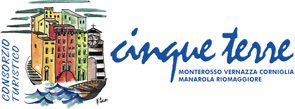The mountains, almost 800 metres high, which run parallel to the sea assure that the Cinque Terre are protected from the cold winds. The hotter and damper southern currents, go back up towards the crest and collide with the cold ones, being the cause of frequent mists and a high rain level.
The typically Mediterranean vegetation consisting in cluster-pine tree, Aleppo pine, oak, sea fennel, red valerian, euphorbia, broom, arbutus and thyme. Of great scientific interest are some endemisms, like the Santolina ligustica, the Centaurea lunensis and the Centaurea apoplepa.
Amongst the animals stand out the presence of seagulls, pilgrim eagles, buzzards, boars, badgers, foxes, and lizards. Whilst in the sea “saraghi”, anchovies, gorgons, poseidons and some sponges.
The beaches
The coast of the Cinque Terre is steep and rocky with an abundance of bays and inlets. The beaches are therefore few and limited, each one different from the other. The largest beach is at Fegina, the new part of Monterosso, judged by the American magazine Forbes as being amongst the 25 sexiest beaches in the world.
The sand in some parts is pebbly and in others fine, split up by evocative rocks, like those of Mapassu or Quarto. Also the old village has its sandy shore equipped with breakwater on the west and rocks of Corone to the east.
Corniglia on the other hand boasts the hottest and most discreet beach. The first is under the train station and is characterised by the presence of a wall which reflects light and heat. Whilst the second is Guvano, destination of nudists. Vernazza, Riomaggiore and Manarola also boast small but charming sandy shores.
The Park
The Cinque Terre have been part of a Parco Nazionale (National Park) since 1999. An institute, the only one in Italy with the purpose of protecting the landscape in which man has created a stable life and of reciprocal cohabitation between himself and nature. At the same time as the Park, the Area Marina Naturale Protetta delle Cinque Terre (Natural Protected Marine Area of the Cinque Terre) was instituted, between Punta Mesco on the west and Punta di Montenero on the east, subdivided into three bands with different grades of protection (A, B and C), usable only in determined conditions.
The aim is to protect the marine environment and the biodifference, characterised by species of animal and vegetable not common in the rest of the Meditteranean. Here Gorgonie and Posidonia in fact form vast under sea prairies, natural refuge for many marine species.
info
Via Discovolo snc – c/o Stazione Manarola – 19017 Riomaggiore.
Ph. +39 0187.762600
info@parconazionale5terre.it
www.parconazionale5terre.it





